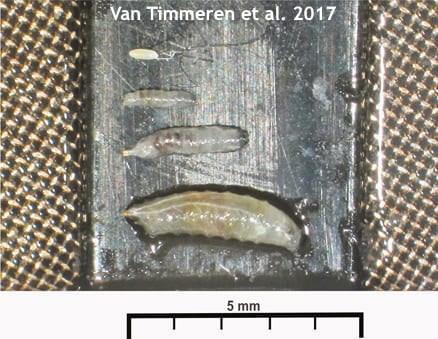Reminder to Start Monitoring Spotted-wing Drosophila
Dr Kelly Hamby has reported that she has been catching Spotted-wing drosophila (SWD) in traps in Central and Western Maryland for a few weeks now, so if you have not yet, it’s time to put up SWD traps for monitoring. They prefer fully colored ripe fruit but are capable of infesting fruit that is just starting to turn color.
Check fruit by visual inspection for soft and leaky fruit, or you can monitor it by using salt or sugar water solutions to float eggs and larvae out of fruit. Salt or sugar water solutions can be used to float eggs and larvae out of fruit to monitor fruit infestation. Collect market-ripe fruit if you want to know if your management program is working. If you want to evaluate SWD pressure, collect interior soft and overripe fruit. Lightly crush the fruit in a plastic bag. Add salt (1 cup salt to 1-gallon water) or sugar (1/4 cup granulated white sugar to 4 ¼ cups water) water and let the fruit soak below the surface for 15 – 60 minutes (the longer, the more likely the larvae will leave the fruit). Pour the fruit and water solution through a coarse filter (to remove the fruit) stacked over a reusable basket-style coffee filter. Rinse the soaking bag/container and pour the rinse liquid through the coffee filter, too. The coffee filter will collect the eggs, larvae, and smaller plant parts and fruit flesh if the fruits were crushed a bit too much. Carefully inspect the filter for SWD eggs and larvae with a magnifier (fig 1 ).
Due to their broad host range and quick reproduction, SWD are difficult to manage. In most cases, especially in preferred hosts such as caneberries and later season varieties, a 7-day spray interval is required to maintain near 0 infestation levels, with tighter intervals when rain events occur. Accurate calibration of sprayers, appropriate spray volumes and tractor speeds, and other best practices to ensure good spray coverage are essential.
There are multiple effective insecticide modes of action for SWD, with group 1A carbamates (e.g., Lannate®) and group 1B organophosphates (e.g., diazinon, malathion), group 3A pyrethroids (e.g., Mustang-Maxx®, Danitol®), group 5 spinosyns (e.g., Delegate®, Entrust®), group 28 diamides (e.g., Exirel®, Verdepryn®) and the premix Cormoran® (group 4A neonicotinoid + group 15 benzoylurea) all ranking good to excellent. For organic production, there are a few OMRI approved materials, with Entrust® being the most effective option. Rotating modes of action (at a minimum, alternate) helps avoid insecticide resistance.
When selecting an insecticide, consider the temperatures at your field during and after the spray application. High summer temperatures positively affect some of the recommended insecticides for SWD management. In contrast, high temperatures adversely affect others, and they rapidly lose effectiveness when temperatures exceed 80 degrees Fahrenheit. The label is the law, make sure the product is registered in your state and crop(s) and follow all restrictions.
SWD prefers to inhabit shady places where humidity is highest. Adjust ground speed, spray volume, and nozzles to ensure the spray reaches through the whole canopy.
Removing and destroying cull fruit and shortening harvest intervals to every 2-days can help reduce on-farm population. For some operations, mesh netting (1.0 x 0.6 mm or smaller) has proven very effective for delaying or reducing SWD. However, sprays may be needed later in the season if populations build under the netting, and supplemental pollination should be considered for some crops. Netting must be installed before SWD are active and cannot have any holes or be left open (e.g., worker or picker entry), so structures with entryways work best. Fruit yields and quality tend to be better when using netting, which also protects from birds and other damage. Cooling fruit (32-36˚F) and holding it cold throughout the supply chain increases shelf life and reduces the likelihood that infestation will result in damaged or unmarketable fruit.
This article appears in Volume 15, Issue 4 of the Vegetable and Fruit News.
